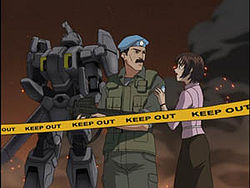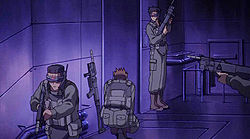Mithril: Difference between revisions
Created page with 'right|thumb|MITHRIL patch as used by most of the series' main characters on their uniforms, though not animated. '''Mithril''' is an anti-terrorist p…' |
(No difference)
|
Latest revision as of 16:39, 16 April 2013

Mithril is an anti-terrorist private military company.
Overview
Mithril is a worldwide military (non-governmental) anti-terrorist organization possessing advanced technologies and weapon systems superior to that of any national armed forces. It was founded around 1992-1993, following the detonation of a nuclear warhead in northern Iraq in the then waning Gulf War. It is named after the fictional metal, Mithril, from the The Lord of the Rings written by J. R. R. Tolkien. The organization's purpose to halt regional conflicts, in addition to securing the Whispered without taking any sides As such, it is one of the few organizations aware of the Whispered and Black Technology.
Mithril remains an extremely secretive organization, its existence unknown to all but the most senior of military and political personnel. Its motives, funding, structure, and personnel are all kept secret. Its secrecy is vital for its continued existence, as Mithril is a specialist organization dependent on fast surgical strikes with small numbers. They do not possess the numbers or capacity to withstand a conventional war of numbers.
Organization
Mithril is divided into three divisions, Research, Intelligence, and Combat, which are overseen by the General Council.< The current chairman of the General Council is Lord Mallory. Additional divisions may exist, but have not been mentioned at this time. The three divisions operate across international borders with the best and brightest available personnel.
The command structure of Mithril is very direct to give soldiers a clear chain of command to their superior officers. At the same time, commanders are given the ability to individually take command of a situation. The high level of trust in individual ability gives each organizational unit a strong level of autonomous decision making.
Research Division
The research division develops advanced Black Technology devices from the knowledge gleaned from the Whispered. There have been a number of Whispered who have taken active part in the Research division as personnel as well. The research division of Mithril is deeply involved with the various cover corporate identities operated by the organization. The organization markets spin off technologies of its research. This revenue is assumed to be part of the funding of the two other divisions. The head of Research is Dr. Painrose.
The research division is shown to have a close working relationship with the combat division of Mithril. There is a personnel exchange program, further fostering this relationship.
Intelligence Division
The intelligence division of Mithril handles the intelligence and counterintelligence duties within the organization. The division is highly independent of the two other divisions, maintaining a higher level of secrecy within the already secretive organization. The division operates an impressive amount of assets, including a number of military satellites, advanced computer equipment and personnel within other organizations. They have been shown using the United States intelligence satellites through morally dubious means. The intelligence division is charged with finding and securing Whispered as well. The head of Intelligence is General Mayer Amit, formerly from Israel and an ex-Mossad secret agent. Agents and officers of the division operate under the codename Ogma.
A certain amount of friction between the Combat and Intelligence divisions have been highlighted within the narrative of Full Metal Panic. This friction does not prevent the division from being highly effective in monitoring the hotbeds of regional conflicts.
Combat Division
The Combat Division of Mithril is the physical muscle of Mithril, carrying out surgical strikes to halt or help abate regional conflicts. The combat division is further divided into five fleets, the North Atlantic Fleet, the South Atlantic Fleet, the Indian Ocean Fleet, the Mediterranean Sea Fleet and the West Pacific Fleet. Within each fleet are battle groups, such as the Pal Horon Battle Group of the North Atlantic Fleet, which operates primarily in the Mediterranean Sea. The head of the Combat Division is Admiral Voda, formerly from the United States Navy.
The Tuatha De Danaan Battle Group is commanded by Admiral Teressa Testarossa, from the flagship of the same name, TDD-1 Tuatha de Danaan while using the codename Ansuz. Commander Richard Mardukas is second-in-command and Lieutenant Commander Andrei Sergeivich Kalinin was military strategist.
Mithril is a specialist organization unlike most armies, requiring personnel capable of completing sensitive and difficult operations in small teams. These small surgical strike teams are operated by each battle group, under the Special Response Team (SRT) and Primary Response Team (PRT) units. They are armed rapid response units deployed around the world, most often within a day or even hours. The SRT are deployed to the most dangerous and risky of situation, ones that the PRT cannot be expected to complete.
Special Response Teams and Primary Response Teams

SRT and PRT operators of the Pacific battle group operate under code names during field operations. These code names are letters from the Runic alphabet. SRT members are designated Urzu (Urzu) while PRT members are designated Kaunan (Kano). These runic letters each carry a symbolic meaning well suited to the units. For example, Urzu means power while Kaunan means beginning.
In their need of secrecy, these Mithril soldiers often disguise themselves as armed forces of various nations. In Full Metal Panic, they pose as UN peacekeepers by wearing blue berets and green BDUs fitted with UN insignias.
Under the direct command of Lieutenant Commander Andrei Kalinin, who has the call sign of Perth-1, the ground combat units of the Tuatha de Danaan battle group are separated into SRT and PRT units. There are six PRT units, each one specializing in a particular type of warfare. They are air assault, amphibious warfare, espionage, assault, communications, and building breaching and assault. Soldiers rotate within the six teams to learn the methods and skills of each team. The Primary Response Teams form the core fighting force of the Pacific Fleet. Most operations of Mithril are carried out by the PRT. Urzu Three is commander of the Primary Response Teams, and facilitates the communication and teamwork between the SRT and PRT personnel.
The distinction of the SRT from the PRT is the usage of Arm Slaves. Almost all SRT members are Arm Slave pilots in addition to their specialist skills elsewhere. This is largely unheard of, and highlights the unique nature of the SRT. Each specialist of the unit is encouraged in cross training to retain the ability to complete a mission regardless of personnel loss in the field.
While most missions operate the SRT and PRT personnel as discrete units, complex operations have been shown using both SRT and PRT units. In these cases, SRT personnel have been shown to take command of supporting PRT units. The two teams show strong integration, showing the well trained nature of both units.
Equipment

In order to conduct their missions, Mithril Response Teams are armed with the finest military equipment that is available to them. Much like Special forces operators of most countries, SRT personnel are given complete freedom in the equipment they choose to arm themselves with. This serves to make each individual member difficult to identify as a part of Mithril based on their equipment. Equipment shown used by Response Teams in the series include the FN P90 submachine gun and an assault rifle/hand gun combination similar to the CornerShot system.
The cornerstone of the West Pacific Battlegroup, Tuatha de Danaan, is the amphibious assault submarine TDD-1 Tuatha de Danaan. The ship shares its name with a legendary race of people who are feature prominently in Irish mythology.
The standard complement of Tuatha de Danaan is four FAV-8 Super Harriers, six MH-67 Pave Mare Transport Helicopters, and four RAH-66 Comanches. Additional equipment fielded by Mithril are a turbofan variant of the C-130 Hercules, C-17 Globemaster III transports, and MH-60 Pave Hawks. It is notable that many of these weapon systems operated by Mithril include a number of equipment that are from failed or canceled development programs. It is unknown if the addition of Black Technology have made these projects viable.
Most notable is the advanced Sixth Generation Arm Slave, yet unmatched by any military of the world. SRT operatives are issued the M15E Walther Arm Slaves for general Arm Slave combat or missions. Each SRT member customize and personalize the Arm Slave extensively, creating a close relationship with their machines. The Battlegroup also operates a number of older M9 Gernsback units as secondary and backup units, but do not carry any on the limited space of the TDD-1.
Mithril as an organization has access to low orbit satellites for an encrypted communications network and intelligence gathering, codenamed as Sting. Illegal and unauthorized access of United States satellite network has been mentioned. It is unknown if Mithril possesses its own orbital assets or only borrows from other nations.